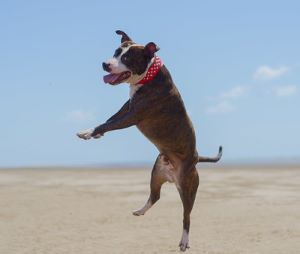Dogs sustain all manner of weird and wonderful injuries. A major one is tearing the CCL – kind of like the ACL in humans.
This is a big deal, and undergoing surgery to repair the damage is a big deal.
Your pup will be out of action for about a month, after which you can slowly introduce exercise again.
But what happens if he jumps or starts horsing around too early? Could he undo all the good your vet did? Let’s find out.
What is TPLO dog surgery?
TPLO surgery is short for Tibial Plateau Levelling Osteotomy.
What this means in ordinary person language is that the ligaments keeping your pup’s knee together in his hind leg snapped.
To repair this, the vet will do surgery to change how the knee looks, enabling your pup to walk again, despite having torn his ligament.
Side note: the ligament in question is called the CCL, or cranial cruciate ligament.
This one attaches the bone above the knee (femur) to the bone below the knee (tibia) in your pup’s hind leg.
When this happens, your pup becomes lame and is probably in considerable pain.
In dogs, the tibial plateau, or shin bone, isn’t at right angles with the ground when it bears maximum weight.
Instead, it’s slightly slanted.
So, if the tendon that helps spread this load snaps, your poor Rover can’t walk the way he used to.
When he puts his weight on that leg, the shin bone “slips,” and so it feels as though his knee is giving way.
During TPLO surgery, the vet shaves a bit off the end of this bone, changing its angle to the floor during weight-bearing.
This stabilizes Rover’s knee, enabling him to walk more efficiently, even though the ligament is still damaged.
To strengthen the repair, your vet will attach a small metal plate to the bone.
This one is specially made for these repairs and fastens to the bone with small screws, like in human surgeries.
How long after the surgery is it before a dog can jump?
Recovery from TPLO surgery takes weeks, and your dog won’t be able to exercise during that time.
You can let him out to go potty, and that’s about it.
During this time, he’ll go for regular check-ups at the vet, who will recommend a program for introducing exercise again.
This all depends on how well your dog is recovering, and it differs from dog to dog.
So, unfortunately, there’s no set rule indicating when your dog should be able to jump again after TPLO surgery.
Once your pup is strong enough, your vet will probably recommend hydrotherapy.
This is a good way of training your pup’s muscles again without putting too much weight on his joints.
Why do dogs need TPLO surgery?
TPLO surgery mainly repairs the damage caused by CCL tears (that’s cranial cruciate ligament rupture – like me, you probably felt the urge to Google that).
Since this surgery is quite extensive, and many things could go wrong, it isn’t something your vet will recommend lightly.
So, if your dog is persistently lame and his knee joints are acting up big time, the benefits of TPLO surgery will probably outweigh the risks.
In this case, your vet would likely give it a go.
The CCL is similar to ACL in humans.
Unfortunately, that ligament is like to proverbial sitting duck, and many dogs suffer from damage to it.
Many factors exacerbate the risk of injury, but luckily, some of them can be avoided or at least mitigated.
Obesity ranks relatively high on the list since excessive weight gain places considerable strain on your pup’s knee joints.
If an overweight pooch attempts a jump or even a fast pull-off when chasing a ball, his knee joints are likely to check out, causing that dreaded CCL injury.
Let’s face it: a healthy lifestyle puts your pup miles ahead in terms of health and risk management.
Then, there are the weekend warriors.
You know, the pups who go all out over the weekend, getting in some serious exercise, then going back to couch potato mode for the week.
Just like with humans, their bodies weren’t made for this stop-start arrangement. Continuous, consistent exercise is essential – if you want to avoid injury, slowly work your way up to your intended activity level.
Don’t shock your pup’s body with exercise – instead, help him be consistent with it.
Suppose your dog has a CCL injury in one leg.
In that case, he’s also highly likely to suffer a similar injury in the opposite leg.
It’s as though his body says, “okay, fine. You can have the other one too.” Here, prevention is the best cure.
Dogs that are prone to arthritis and osteoporosis are also more likely to suffer severe CCL injuries since their joints are already weakened from these conditions.
It’s important to note that there are usually warning signs before a severe CCL injury.
Usually, your pup’s knee joint will take strain over a prolonged time, causing increasing lameness, especially after physical exertion.
If you pick up on this early on and get help from the vet, you could prevent serious injuries.
Usually, this will involve lifestyle changes to accommodate your pup’s risk of CCL injury.
Suppose you don’t pick up on this. In that case, he’s likely to suffer serious injury from a seemingly insignificant event, like a slight misstep or even a low, gentle jump off the porch.
How should you protect/ confine your dog after TPLO surgery?
TPLO surgery is a massive operation, and your dog will need weeks to recover.
It may take up to three weeks before your pup’s injured leg can bear any weight.
Even if he can bear weight on that leg, he shouldn’t do so during the first eight weeks post-surgery.
This will allow enough time for poor Rover to heal properly.
Since dogs love exercise, and your Rover will likely get bored and try to chase the mailman, a squirrel, or even his own tail, you might have to lock him up for a bit.
A crate lined with clean bedding is usually a good option, depending on your pup’s temperament and conditioning.
When you take Rover to go potty, keep him on a leash or harness to prevent him from getting up to mischief.
Sometimes, that’s the only way to keep him from jumping, running, and playing.
The wound left after the operation is likely to itch as it heals, so many dogs lick and bite at it incessantly.
This could cause stitches to pull out or even open up the wound completely. Obviously, that’s not good for healing.
So, if your dog licks at his wound, he may need one of those cone collars to keep him from reaching the area.
He’ll probably look sheepish and have a hard time reaching his food bowl without the collar bumping it, but that’s preferable to ripped stitches.
Poor Rover.
What are the exercise restrictions after TPLO?
As mentioned earlier, your pup can’t (and shouldn’t) bear weight on his injured leg for at least three weeks post-surgery.
That’s a really long time, especially for a confined dog. Unfortunately, three weeks doesn’t mark the end of it.
For the first eight weeks post-surgery, your pup’s exercise should be severely limited to allow adequate recovery.
Your vet will assess your pup and advise you on when and how to reintroduce exercise.
For this, hydrotherapy works well since it allows your pup’s muscles to move in their full range of motion, without the strain of weight-bearing.
Your vet will probably give you guys some homework as well, prescribing gentle range-of-motion exercises to retrain Rover’s muscles.
What is the success rate of TPLO surgery?
While TPLO surgery is a significant procedure that carries considerable risks, the success rate is a whopping 90%.
For this reason, it’s often used on larger dogs or dogs that perform athletically.
What are the symptoms of TPLO surgery failing?
TPLO surgeries sometimes go wrong, and picking up on the warning signs early on is essential. So, what are the warning signs?
Basically, you’ll notice that your pup’s not healing. He’ll show signs that he’s in pain, many weeks post-surgery. He also won’t be able to bear weight on the injured leg.
In severe cases, where infection sets in, your pup could run a fever and show signs of serious illness, such as vomiting, disorientation, excessive drooling, and even fainting.
If you notice any of the above signs, or if you’re not sure that your pup’s recovery is going as well as it should, talk to your vet. Rather be on the safe side with this one.
Are any breeds more at risk of CCL injuries than other breeds?
Unfortunately, your dog’s breed could increase his risk of suffering from (CCL) injuries.
Breeds that are especially at risk include Labradors, Newfoundlands, Rottweilers, German Shepherds, and Golden Retrievers.
This reads like a hit list of dogs genetically most likely to suffer from arthritis or osteoporosis. Sorry, guys.
Closing Thoughts:
TPLO surgery is a big deal and will require significant sacrifice to nurse your pup back to health, but the success rate is high.
If your pup underwent this procedure, you’d have to keep him under lock and key for a few weeks to keep him from jumping and playing.
Other than walking outside to go potty, physical activity is a hard no since it could cause irreparable damage to the injured area.
It’s worth it, though, since your pup will likely heal well and be back to his old self before you know it.






